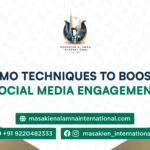
How to Use SEO to Boost Your Content Marketing ROI
In our digital era, content marketing has emerged as one of the most powerful tools businesses can use to develop trust, educate audiences, and convert leads into customers. Yet the strength of your content means nothing if no one ever sees it. SEO- Search Engine Optimization- thus becomes paramount. Any SEO strategy essentially works toward making content more discoverable by placing it high up in a search engine results page, driving organic traffic to it, earning some authority, and then subsequently increasing ROI.
Most companies reasonably put a lot of energy into content creation but do very little to promote SEO, a component so necessary for long-term success. SEO, contrary to popular belief, isn’t just about placing keywords here and building links there—it’s about understanding how search engines operate and telling them that your content is what your audience is looking for. SEO, when focused on strategy, finds the right traffic, not some generic traffic that barely converts. Here’s a comprehensive detailing of how SEO benefits your content-marketing ROI and what precisely you need to do to get started on the practical side.
Understanding Content Marketing ROI
Content marketing ROI considers the input factors such as current hours, costs, and human resources required in content creation, promotion, and distribution. The return on investment is considered as how much the content leads to or results in value-grounded sales or fulfillment of other key performance indicators, as compared to the investment made.
For instance, let’s consider you spend $1,000 in creating a set of blog posts; eventually, those posts result in $5,000 worth of product sales or customer leads—an absolutely positive type of ROI. Non-monetary ROIs can include activities such as building brand awareness, driving traffic to sites, or audience engagement. That is where SEO works its magic. Check out our latest blog post on 3 Types of Pillar Page Every Blogger Should Know.
Why SEO Is Important for Content Marketing Success
While SEO helps your content become visible to those seeking information on the services and products you provide, the inability to implement SEO will mean that even the most highly informative, well-written content will stay down there in the obscure heights of search, never to be discovered by potential clients. SEO closes the gap between your content and your audience, ensuring that your efforts bear concrete results.
Regular and quality traffic gets brought to your website through search engine visibility, an effect conferred by SEO upon your site. Lead generation gets a boost from this while the establishment of a credible brand identity also takes place. When users see the great ranking of your content in search results, they consider it authoritative and trustworthy. Along with this, SEO will help you attract that user who has full intent to buy and is interested in what you are willing to offer, increasing the chances for engagement and conversion.
Keyword research: the basis of content SEO The initial step towards SEO optimization of your content is in-depth keyword research. It means getting into the search terms exact words and phrases that the people of your target market are employing to search for pieces of information about products or services that you offer.
SEO content has a structure that is simple to understand by both users and search engines. This has clear headings, subheadings, short paragraphs, and good placement of visuals. It is tedious to stuff keywords—or, better said, attempt to stuff keywords without regard for readability. Natural keyword integration should come first. The content is good for the audience and serves the needs of algorithms. When content is both informative and optimized, it ranks higher in search results and brings in more ROI.
On-Page-Level Search Optimization Techniques
It includes anything and everything within your control on a given web page that can improve that page’s ranking on a positive note. Metatags and headlines belong here, along with URL structure, descriptions for images, and internal linking. They are means for what search engines might consider use to discern what the content is actually about and how relevant it is to actual questions.
Putting target keywords in the title tag, meta description, and headers would give genuine signals to the search engines about the topic under discussion. Additionally, descriptive and uncluttered URLs are good for SEO and the user. Internal linking to related content on your site will keep users engaged longer.
Writing for Search Intent, Not Just For Keywords
One of the most common mistakes in SEO is to focus on keywords without paying any attention to their intent. Search intent is the reason behind the typing of a specific query into a search engine—it may be to learn something, compare options, make a purchase, or find a specific page. If your content meets the keywords but not the intent, then it is not going to do well.
In addressing search intent, one needs to realize what the audience is searching for. For instance, a person searching for “best budget smartphones 2025” is probably looking for a comparison or review article rather than a sitemap for a bunch of product pages. The content created to satisfy this intent would be more engaging and lead to higher conversions. Pairing the tone of your content (blogs, lists, videos, product pages, etc.) with what the user intends will skyrocket the SEO benefits of the content and the eventual return on investment.
Structuring Content for Users’ Better Experience
In fact, structuring your content properly can greatly influence SEO and user engagement. Well-structured content means a coherent, easy-to-read text that users can simply browse through and gracefully digest. Naturally, users may stay longer on your page while growing less impatient to bounce away.
To ensure a great structure, the content must have clear sections marked by headers (H1, H2, H3). Keep short paragraphs with bullet points or numbered lists when necessary to maximize readability. Pictures, charts, and videos relevant to the topic may support the text to give a fuller experience. A nice structure encourages overall better experiences throughout, more staying time, chances of sharing, and all the levels of boosting your ROI.
Make sure of Mobile and Speed Optimization
More users are browsing websites on their mobile phones these days, thus making it imperative to optimize them for a smooth mobile experience. Google also applies mobile-first indexing, whereby it mainly looks at the mobile version of your site to rank it. Ranking will go down the drain, along with visitors, if your content does not load fast and display well on smartphones.
Mobile optimization means responsive design and readable buttons and text on smaller screens, with adjusting intrusive popups. After that comes speed; people expect to wait a maximum of 3 seconds for anything to load. Compress images, enable cache, and minimize scripts. These technical aspects affect SEO performance, user satisfaction, and conversion rates—all of which contribute to a high ROI.
Using SEO Analytics to Track Performance
In order to find out what SEO can do for your content marketing ROI, you need to track your performance using analytical tools—it means measuring metrics like page views, bounce rate, click-through rate, keyword ranking, and conversions. It is from these data that you decide what works and what needs to be fixed.
Google Analytics and Google Search Console are essential free tools that give you data on user behavior, traffic sources, and search performance. More advanced platforms like SEMrush and Ahrefs offer deeper keyword and backlink analysis. Regularly monitoring your content’s SEO performance allows you to adjust the strategy, give more attention to high-performing content, and convert underperforming pages into potential profit-making areas.
Repurposing and Updating Existing Content
Another way to improve ROI is by taking full advantage of whatever content you may already possess. Repurposing and updating content help build new outreach opportunities, serve as an SEO ranking factor, and increase content longevity. Instead of publishing new content every day, consider a makeover of your older posts with new statistics, consideration for different keywords, and different images.
This way, you reach varied audience preferences and staggered distribution channels. Updating and repurposing content is equally cost-effective and SEO-friendly since search engines look well on actualized and relevant information.
Building Backlinks to Enhance Authority
Backlinks are links generated from other websites to your content, and they remain among the most potent SEO ranking factors. When respectable websites place links to your content, the search engines assume that your content is deemed trustworthy or valuable. This should boost its rank and visibility, thus bringing in the much-desired organic traffic.
Backlinks are earned by having worthwhile content and deserve backlinks for being original, insightful, or data-driven so that they may be naturally referenced by others. Then again, you can reach out to some industry-relevant blogs to contribute guest posts or create digital PR campaigns. Backlinks of quality outweigh backlinks of quantity. High-authority backlinks elevate SEO and bring referral traffic of their own, adding to a higher ROI for your content.
Align SEO with the Buyer’s Journey
To truly enhance content marketing ROI, SEO has to back every stage of the buyer’s journey—from awareness and consideration to finally the decision process. Different kinds of content address various objectives, and SEO ensures the proper content is provided to users according to their stage of the journey.
The SEO strategy needs to target informational keywords through blog posts and how-to articles at the top of the funnel. At the bottom of the funnel, implement conversion-related keywords on product and landing pages. Topics based on SEO and the buyer’s journey present the most natural way for prospects to convert from your side, so content marketing becomes more effective and profitable.
Conclusion: Put your SEO efforts to the greater good of your content
SEO is not just a technical realm—it is a strategic asset, having the capabilities to make your content work double time for you. Do spend a little time on keyword research, on-site optimization, monitoring, and results structuring of content, and there will be a skyrocketing of both visibility and engagement. Contact us as In a world where attention is scarce, SEO gets your content in front of the right people at the right time. It also supports long-term growth through sustainable organic traffic and conversions. If you want your content marketing to produce real, measurable results,




